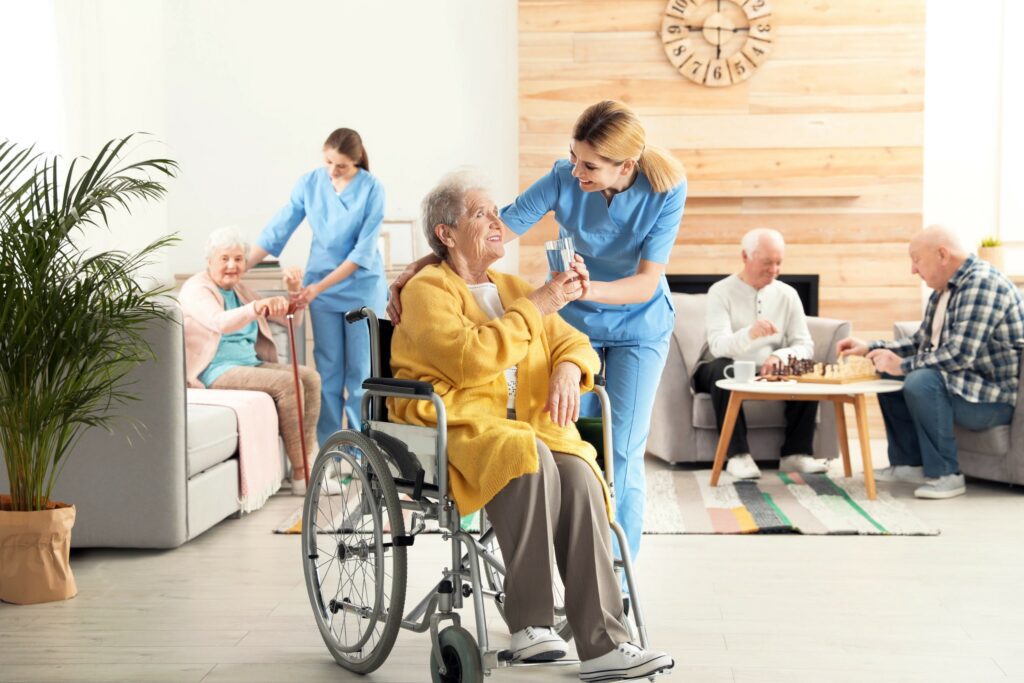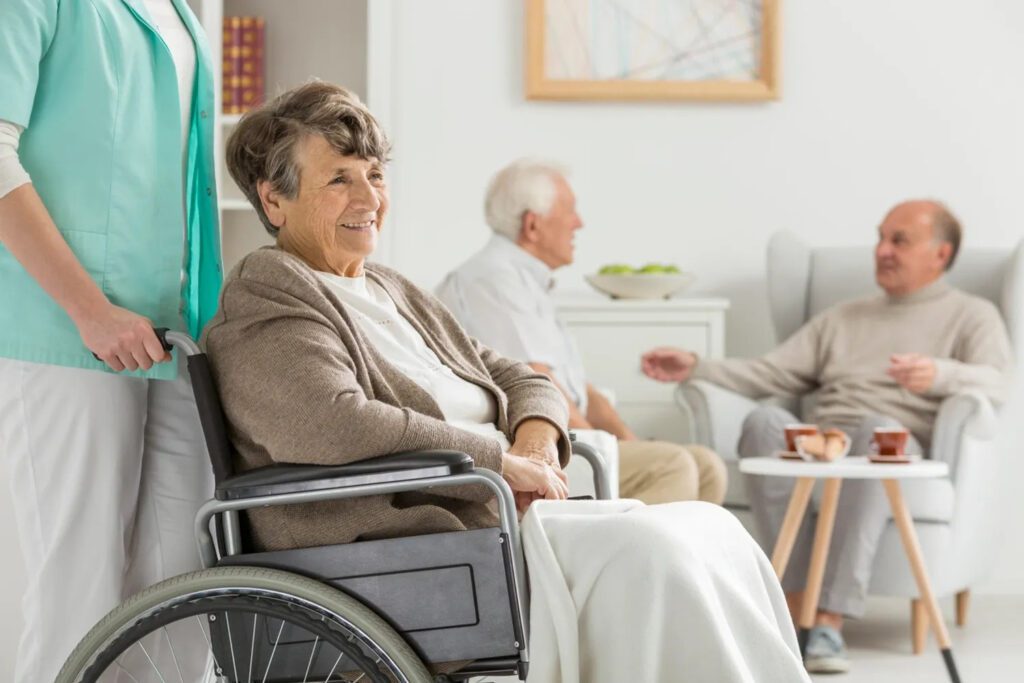Nursing Homes: The Good and The Bad
When comparing nursing homes for a loved one, diligence is key. It requires time, effort, and a lot of research because you want the best choice for yourself or your family.
So whether you’re visiting a nursing home or care facility to decide whether the facility is the right fit for a loved one or to see a loved one currently residing in a home, you should take note of the facility’s condition and the resident’s interactions and mood.
Specifically, you should look for red and green flags during your tour, visit, or research.
Nursing Home Red Flags You Should Know
1. Bad odors
If you notice the scent of urine, vomit, or any other odor, that could be a warning sign that the facility is not being cleaned properly or quickly or that residents may have soiled themselves.
2. Dirty facility
Check whether a facility is unclean; this indicates that staff members and caregivers may neglect other care-related duties. Additionally, unclean environments might serve as havens for infection and sickness. In some cases, this can be fatal for older adults with compromised immune systems.
3. A high number of COVID-19 infections and deaths
A high percentage of Covid-19 infections and deaths in nursing homes could indicate a lack of concern for their patient’s lives and health requirements. They might want to avoid paying for appropriate sanitization and disinfection procedures. They have to do better in implementing safety procedures and controlling infections. They may also need to ensure that all their employees are fully immunized.
4. Delayed response times
Be aware of how long it takes personnel to reply to requests from residents or when they don’t. A slow response time or no response could indicate that there are not enough staff members per resident or that they should be more attentive. To estimate response time, look at the call lights on the residents’ doors.
5. High turnover rates
The level and consistency of care provided to residents may suffer if nursing home staff and administration are frequently changed. This could also indicate that the nursing home is hiring temporary or unqualified staff members to fill staffing gaps, which is a warning sign.
6. Lack of knowledge among staff
Nursing assistants and charge nurses should be able to answer all of your inquiries about procedures, daily schedules, and treatments.
If the staff cannot respond to these queries, it implies a lack of training and also raises the possibility that they are not adhering to standard standards and care procedures. This also implies that the residents are not receiving the required level of care.
7. Lack of abuse prevention policies
The facility should have a set policy and procedure for handling abuse and neglect complaints. A program to avoid abuse should be available for both employees and residents.
8. Residents of the nursing home look unkempt
Seniors with untidy hair, unkempt clothing, missing dentures, or foul breath may not be receiving the help they require for everyday personal hygiene.
9. Lack of activities.
Nursing facilities should take action to involve residents in daily activities and events. Imagine you observe residents staying in bed late or giving a few things, such as gym classes, religious services, or entertainment. Then you ought to see that as a negative omen. Residents may experience emotional neglect in the facility if they are left out or unable to socialize and have fun.
10. Has a history of abuse and neglect complaints
Facilities with a track record of such complaints are likely to repeat violations and complaints involving home neglect and abuse. A history of abuse and neglect should indicate that you should seek other care.
11. Low-quality food
Take note of the food the nursing home serves you while you are there. Even though you can’t anticipate a four-course meal prepared by a Michelin-starred chef, you should anticipate that residents will receive wholesome meals. Since poor food quality can have an impact on your loved one’s health and nutrition, it might be a warning sign.
12. No evidence of privacy
An older adult has the right to privacy regarding personal objects and belongings. There is a risk of theft or financial abuse if a resident’s room does not include a safe or lockbox to protect their belongings.
13. Poor visiting policy
The lack of a good visiting policy is another warning sign for a care home. It may indicate that a facility needs to be more staffed or has something else to cover up if it prohibits unannounced visits or has rigid visiting hours. It’s crucial to remember that visiting hours should only take place during appropriate times. a place that closes its doors to guests at 2:30 in the morning or the wee hours of the morning is to be anticipated.
14. Rude and dismissive staff
A skilled nursing facility that gives its residents above-average care is polite and open to your queries. This behavior may indicate how they interact with locals and respond to their inquiries or complaints.
15. Unsecure location
Access to good, secure outdoor areas should be available to residents. However, if the facility is located in a dangerous area, it could be cause for concern, especially if there is insufficient security or no gates.
16. Unresponsive residents
When you visit the residents, if many of them seem unresponsive, it may be because some of them have been administered antipsychotic drugs without having a condition that justifies such prescription, according to experts. As a result, the institution may be operating with insufficient staff, as evidenced by its use of these drugs to control difficult-to-manage behaviors, particularly among patients with dementia or Alzheimer’s.
17. Forced activity
Residents are free to decline invitations to participate in events. A red flag of abuse is when a resident is forced to perform something by a staff member.
18. Residents seem agitated or confused
Abuse and neglect can cause agitation, confusion, disorientation, anxiety, and sadness. A resident may suffer if you detect an increase in one or more of these behaviors from them.
19. Bad reviews for the nursing home
Residents and their relatives are not compelled to fabricate negative reviews about nursing homes. The opinions are factual or have a basis in reality if you conduct an online search for a specific facility and find numerous negative evaluations.
Qualities Of A Great Nursing Home
It is crucial to understand what a respected care facility entails. Good circumstances are crucial when it comes to your or a loved one’s safety and well-being.
So it is also important to note the tell-tale signs of a great nursing home, such as those stated below:
1. Proximity to the resident’s family
The likelihood of visiting or speaking with employees increases with a facility’s proximity to your house.
2. Welcoming atmosphere
Never choose a nursing home based solely on how the outside, courtyards, common areas, or rehabilitation units seem. Think about whether the spaces are hospitable or resemble sterile hospital rooms.
3. Ensures safety
You want a facility that has been carefully cared for, from the structure to the interior decor and machinery. Keep an eye out for symptoms of deterioration like frayed carpets, used linens, or broken chairs that could provide risks or discomfort.
4. Adequate staffing
It’s critical for your loved one’s health to have enough staff. Numerous professionals, such as doctors, registered nurses, family counselors, certified nursing assistants and aides, physical therapists, wound care specialists, and registered nurses, should work at the nursing home or frequently visit the site.
5. Has compassionate staff and management
Ask to connect and speak to nurse leaders or activity leaders in addition to taking a virtual tour and speaking with administrative leaders of a facility to get a sense of their interpersonal abilities. Be alert for indications of compassion and empathy.
6. Staff retention
Heavy turnover is a clear sign of dissatisfied employees, and unhappy employees may result in subpar care. A good nursing home should have strong staff retention rates and employees who feel they are contributing to something worthwhile.
7. Consistent assignment among staff
Find out from administrators and other staff members if the same residents are served by the same caregivers each time they are on duty. A regular assignment would be this. To better care for residents, it aids caregivers in better understanding their requirements. Additionally, it makes occupants feel safer and more at ease.
8. Good interaction with residents
The tiny encounters between residents and staff determine whether staff members appreciate and care about them. Some tell-tale symptoms of this are whether nurse staff members respect residents’ privacy by knocking before entering or addressing them kindly and by name.
9. Flexible visitation
The greatest nursing facilities had open visitation hours before the pandemic. Due to COVID-19 dangers, most nursing facilities have since tightened visitation policies. However, there are alternative ways to visit or speak with your loved one, which is crucial because loneliness is a severe health risk. Choose a nursing home that allows residents to visit with their loved ones. Find out if, how frequently, and under what conditions you can arrange in-person visits.
10. Offers interesting activities for residents
Pointless games shouldn’t dominate the schedule. Search for a nursing home with various interactive, social, physical, and educational activities. Additionally, it’s critical to consider whether there is an outdoor space where residents can engage in various activities.
11. Provides meaningful tasks to residents
Some nursing facilities allow their talented patients to participate in the worthwhile activities they once performed at home. They could, for instance, deliver mail, offer inhabitants water pitchers, or read to others.
12. Give decision-making opportunities to residents and respect their rights.
Your loved one should have a say in decisions regarding their care, including when to go to bed and wake up, what activities to engage in, what to dress, and what to eat. Inquire about whether residents can socialize and eat together during the epidemic and whether they are permitted to dine in their rooms if they wish to do so.
Bottomline
Selecting the ideal care home for your loved ones can be challenging. You should research the reputation, ratings, and history of the nursing home before making a choice. Recent findings indicate that the data you find online can be partial, inaccurate, or deceptive. Furthermore, it is impossible to predict if a nursing home will present any threats to the residents in the future based solely on a facility’s history.
The senior patients of well-known nursing homes have been known to suffer life-threatening concerns. This is related to the fact that it doesn’t imply that you should fully disregard their safety record. Instead, keep an eye out for nursing home warning signs in addition to routine inspections. This should assist you in locating a nursing home for your loved ones that is trustworthy and safe.
Sources:






